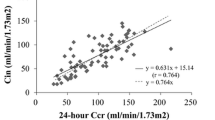Abstract
The predicted reciprocal creatinine at age 10 years (PRC10), a parameter of renal function based upon the linear relationship between reciprocal serum creatinine and age, incorporates age, serum creatinine, and rate of renal deterioration into a single term. PRC10 measurements were employed to assess renal function in children with nephropathic cystinosis treated with oral cysteamine, a cystine-depleting agent. In 71 children receiving oral cysteamine for at least 1 year, PRC10 decreased linearly with initial serum creatinine concentration. This indicated that, although established renal damage in cystinosis was irreversible, early intervention with cysteamine therapy could favorably alter the rate of glomerular deterioration. In other analyses, mean PRC10 was shown to increase with duration of cysteamine therapy and extent of leukocyte cystine depletion. The predicted reciprocal creatinine value at a certain age can be useful in analyzing the effects of therapeutic intervention in a disease with a relatively uniform rate of renal deterioration.
Similar content being viewed by others
References
Shemesh O, Golbetz H, Kriss JP, Myers BD (1985) Limitations of creatinine as a filtration marker in glomerulopathic patients. Kidney Int 28: 830–838
Schwartz GJ, Haycock GB, Edelmann CM Jr, Spitzer A (1976) A simple estimate of glomerular filtration rate in children derived from body length and plasma creatinine. Pediatrics 58: 259–263
Rutherford WE, Blondin J, Miller JP, Greenwalt AS, Vavra JD (1977) Chronic progressive renal disease: rate of change of serum creatinine concentration. Kidney Int 11: 62–70
Leumann EP (1978) Progression of renal insufficiency in pediatric patients: estimation from serum creatinine. Helv Paediatr Acta 33: 25–35
Reimold EW (1981) Chronic progressive renal failure. Rate of progression monitored by change of serum creatinine concentration. Am J Dis Child 135: 1039–1043
Arbus GS, Bacheyie GS (1981) Method for predicting when children with progressive renal disease may reach high serum creatinine levels. Pediatrics 67: 871–873
Gahl WA, Reed GF, Thoene JG, Schulman JD, Rizzo WB, Jonas AJ, Denman DW, Schlesselman JJ, Corden BJ, Schneider JA (1987) Cysteamine therapy for children with nephropathic cystinosis. N Engl J Med 316: 971–977
Gahl WA, Tietze F, Bashan N, Steinherz R, Schulman JD (1982) Defective cystine exodus from isolated lysosome-rich fractions of cystinotic leucocytes. J Biol Chem 257: 9570–9575
Gahl WA, Bashan N, Tietze F, Bernardini I, Schulman JD (1982) Cystine transport is defective in isolated leukocyte lysosomes from patients with cystinosis. Science 217: 1263–1265
Gahl WA, Tietze F, Bashan N, Bernardini I, Raiford D, Schulman JD (1983) Characteristics of cystine counter-transport in normal and cystinotic lysosome-rich leucocyte granular fractions. Biochem J 216: 393–400
Jonas AJ, Smith ML, Schneider JA (1982) ATP-dependent lysosomal cystine efflux is defective in cystinosis. J Biol Chem 257: 13185–13188
Gahl WA, Renlund M, Thoene JG (1989) Lysosomal transport disorders. Cystinosis and sialic acid storage disorders. In: Scriver CR, Beaudet AL, Sly WS, Valle DL (eds) The metabolic basis of inherited disease, 6th edn. McGraw-Hill, New York, pp 2619–2647
Gahl WA (1986) Cystinosis Adv Pediatr 33: 95–126
Gahl WA, Kaiser-Kupfer MI (1987) Complications of nephropathic cystinosis after renal failure. Pediatr Nephrol 1: 260–268
Chan AM, Lynch MJ, Bailey JD, Ezrin C, Fraser D (1970) Hypothyroidism in cystinosis. Am J Med 48: 678–692
Fivush B, Green OC, Porter CC, Balfe JW, O'Regan S, Gahl WA (1987) Pancreatic endocrine insufficiency in posttransplant cystinosis. Am J Dis Child 141: 1087–1089
Fivush B, Flick JA, Gahl WA (1988) Pancreatic exocrine insufficiency in a patient with nephropathic cystinosis. J Pediatr 112: 49–51
Kaiser-Kupfer MI, Caruso RC, Minckler DS, Gahl WA (1986) Long-term ocular manifestations in nephropathic cystinosis. Arch Ophthalmol 104: 706–711
Gahl WA, Dalakas MC, Charnas L, Chen KTK, Pezeshkpour GH, Kuwabara T, Davis SL, Chesney RW, Fink J, Hutchison HT (1988) Myopathy and cystine storage in muscles in a patient with nephropathic cystinosis. N Engl J Med 319: 1461–1464
Thoene JG, Oshima RG, Crawhall JC, Olson DL, Schneider JA (1976) Intracellular cystine depletion by aminothiols in vitro and in vivo. J Clin Invest 58: 180–189
Gahl WA, Tietze F, Butler JDeB, Schulman JD (1985) Cysteamine depletes cystinotic leucocyte granular fractions of cystine by the mechanism of disulphide interchange. Biochem J 228: 545–550
Pisoni RL, Thoene JG, Christensen HN (1985) Detection and characterization of carrier-mediated cationic amino acid transport in lysosomes of normal and cystinotic human fibroblasts. J Biol Chem 260: 4791–4798
Schneider JA, Schlesselman JJ, Mendoza SA, Orloff S, Thoene JG, Kroll WA, Godfrey AD, Schulman JD (1979) Ineffectiveness of ascorbic acid therapy in nephropathic cystinosis. N Engl J Med 300: 756–759
Draper NR, Smith H (1981) Applied regression analysis, 2nd edn. Wiley, New York, pp 33–40
O'Brien PC, Dyck PJ (1985) A runs test based on run lengths. Biometrics 41: 237–244
Armitage P (1971) Statistical methods in medical research. Wiley, New York, pp 395–396
Armitage P (1971) Statistical methods in medical research. Wiley, New York, pp 288–294
Yudkoff M, Foreman JW, Segal S (1981) Effects of cysteamine therapy in nephropathic cystinosis. N Engl J Med 304: 141–145
Gretz N, Manz F, Augustin R (1982) Survival time in cystinosis: a collaborative study. Proc Eur Dial Transplant Assoc 19: 582–589
Author information
Authors and Affiliations
Rights and permissions
About this article
Cite this article
Gahl, W.A., Schneider, J.A., Schulman, J.D. et al. Predicted reciprocal serum creatinine at age 10 years as a measure of renal function in children with nephropathic cystinosis treated with oral cysteamine. Pediatr Nephrol 4, 129–135 (1990). https://doi.org/10.1007/BF00858823
Received:
Revised:
Accepted:
Issue Date:
DOI: https://doi.org/10.1007/BF00858823




